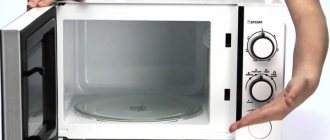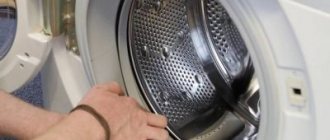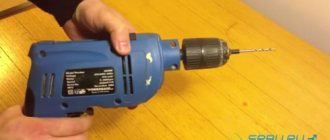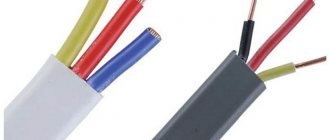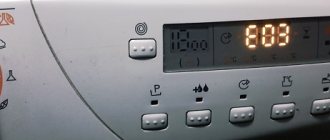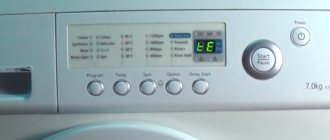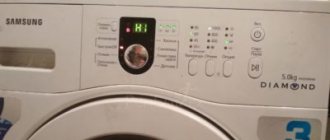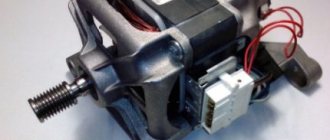Operating principle of a commutator motor
The main elements of the device are located in rotation bearings, which in turn are enclosed in a static frame. Both the motor and the stator have individual windings made of insulated cores - armatures. Electric current flows through the latter, and, as a result, magnetic fields with north and south poles (N and S) are formed.
Due to their interaction, the dynamic part of the motor, the rotor shaft, rotates. A commutator with a brush mechanism and armatures is precisely what is needed in order to supply the necessary voltage to the windings, due to which the shaft rotates.
Engine diagram
For a more visual understanding of the operating principle of a commutator motor, there are two visual types of representation - simplified and detailed. The first format (Fig. below) is a conventional diagram, focusing on connecting the windings to the network.
More complex designs (Fig. below) have additional taps on the rotor and stator. For example, to power automation or regulate speed. The presence of thermal protection allows you to minimize the likelihood of overheating of the upper layer of the unit winding. This element removes voltage when the relay is activated, stopping the operation of the shaft.
The tachogenerator reflects the rotation speed of the engine. As an alternative, a Hall sensor is installed on some models. The device receives signals through the contacts of the collector panels.
Why do brushes spark?
Brushes can be called the weakest element of a commutator motor: during operation of the unit, they are subject to constant friction, which leads to their wear . This point is especially noticeable on copper surfaces, where a layer of coal dust accumulates during brush operation.
Design Features
In normal sliding mode, a small break occurs in the electric current circuit. Microscopic arcs appear, and this is a faithful companion of sparks. Here you can add a decent inductive reactance of the motor windings.
At maximum load on the unit, even with new brushes, there will always be a spark. Visually this may not be so noticeable, especially on low-power models, but sensitive equipment located in a room with a working vacuum cleaner will make this known in a specific background. Therefore, filters are installed on televisions, personal computers and other devices to eliminate such interference.
Wear
The part of the brush that comes into contact with the commutator is made of carbon. Over time, its length decreases, as does its total volume. As a result, the spring pressure weakens, and gaps appear, and with them sparks.
Graphite brushes for vacuum cleaner
Homemade brush
The element must fit tightly into the grooves and be positioned strictly perpendicular to the axis of the rotor shaft. If the brush is smaller than the required size, a skew will appear. This will again lead to sparking, and at the same time a decrease in engine performance. Therefore, here it is better to give preference to industrial options rather than homemade ones.
Purpose of brushes on angle grinders
Before you find out the reasons for sparking brushes on an angle grinder, you need to understand their purpose. Commutator brushes are used not only in the design of angle grinders, but also in the design of all modern power tools - drills, hammer drills, jigsaws and others. In the design of grinders and other power tools, 2 brushes are used, which have a simple design. This design is based on the following elements:
- The main part is rectangular in shape and made of coal or graphite
- A contact is a wire core of the appropriate diameter through which electric current flows. The contact connects the wire to the graphite part
- A spring is a mechanism that ensures the main part is pressed against the collector. There may be no spring on the element, and this indicates that such a brush is intended for installation in a power tool, where the brush holders have a built-in pressing mechanism in the form of a curved plate
The devices are designed to transmit electric current to the rotor of a power tool. The voltage removed from the stator is supplied to the rotor, which is reproduced using carbon brushes and a commutator. Supplying current to the collector ensures its rotation. When the rotor rotates, the devices come into contact with the collector (copper lamellas are the leads of the armature windings), thereby ensuring the continuous flow of electric current.
During the use of devices, they wear out, so they are classified as consumables. The service life of brushes depends not only on the working life of the power tool, but also on the materials from which they are made. The wear of brushes is affected not only by mechanical impact due to friction, but also by thermal impact. Electric current passing through a conductor causes it to heat up. The higher the current, the higher the heating temperature. When current passes through the graphite brushes, they also heat up. The higher the load on a power tool, the higher the current, which means the temperature increases, which negatively affects the integrity of consumables.
Read also: Chemical properties of synthetic rubber
Replacing brushes
The simplest and most obvious cause of sparks is wear on the brushes. Despite the fact that commutator motors are equipped with special spark-extinguishing capacitors, which, in addition to increasing the service life of these elements, also reduce radio interference, over time the brushes wear out and need to be replaced.
To replace the brushes, you first need to get to the electric motor. To do this you will have to disassemble the vacuum cleaner. In most cases, this is quite simple to do with a screwdriver, but do not forget to unplug the device. Having disassembled the vacuum cleaner and provided convenient access to the engine, we find the brush holders. Depending on the design, to remove the brushes from the brush holder, you usually need to pull out the latches, which may require a screwdriver.
Why do brushes burn out on angle grinders?
In addition to sparking, power tool owners often encounter brushes on their grinders burning. This phenomenon differs from sparking in that rapid wear of the main part of the element occurs. Immediately after installing new elements, they wear out immediately when using the power tool for the first time. We have to figure out why the brushes on the grinder burn.
Read also: Do-it-yourself SVP for tiles
The main reason lies not in the brushes themselves, but in the commutator. If the lamellas fall out or wear out on the collectors, this leads to an increase in load. This load is experienced by graphite elements, which, when the angle grinder is turned on, begin to wear out quickly - this process of accelerated wear is called combustion. Elements literally burn due to the passage of large current. Many people call this process abrasion, but in reality brushes cannot quickly wear out due to mechanical stress. The cause of combustion is strong sparking, as a result of which the graphite literally simply burns out.
The reasons why brushes on an angle grinder burn are as follows:
- Loss or wear of the copper lamellas of the collector. What wear on the collector lamellas looks like is shown in the video. The material also shows how you can try to eliminate such a malfunction.
There is also such a thing as all-round fire. This phenomenon occurs during large impulses of the armature current, for example, during overloads, short circuits, and also when the network voltage decreases. A circular fire appears when the arc is re-ignited. An increase in load and even a short circuit occurs when using an angle grinder to cut wood. When processing wood, the cutting disc becomes clamped, thereby increasing the current by 15-25 times the nominal value. Most often, the commutator is the cause of element combustion, so if you had to change 2-3 pairs of brushes in a month, then it’s time to diagnose the power tool.
Eliminating bad contact
Brushes often spark if they have poor contact with the commutator. This happens if you installed new ones. To ensure a tighter fit of the brushes to the collector, you can use sandpaper or simply let the vacuum cleaner run at medium speed for about 20 minutes. It is imperative to check the condition of the bearings, as their wear can cause runout and uneven rotation of the rotor. Insulation protrusions between the collector plates, scratches on the surface, and various irregularities manifest themselves in a similar way. Abrasive paper is used for polishing.
The device of the collector electric motor of the vacuum cleaner
The brushes should not dangle in the brush holder, but have free movement, which is provided to them by the spring, the condition of which also plays an important role.
If you decide to replace the brushes, be sure to pay attention to how tightly the spring presses them against the commutator. Sometimes, in order for the brushes to press harder, it is enough to stretch the spring a little.
Electric motor design and operating principle
The operating principle of an electric motor is based on the interaction of a conductor with a current located in a magnetic field.
The magnetic field is created by the stator.
The main element of its design for a DC motor is a permanent magnet, for alternating current it is an excitation winding. The rotor (armature) has its own winding, to which voltage is supplied using a brush-commutator unit. The interaction of magnetic fields causes the rotor to rotate.
The collector consists of a set of contacts, which are copper plates located directly on the rotor. Micanite or mica cuffs act as insulators for each individual contact. Graphite brushes are sliding contacts pressed against the commutator.
Transient processes occur in the rotor windings due to intermittent mechanical contact of the brushes with the commutator plates, which causes the formation of small arcs.
Important : a fully serviceable engine does not exclude sparking during operation. There are other reasons that cause severe sparking and create the possibility of motor failure.
Brush wear
With prolonged use or poor-quality brush material, they no longer press tightly against the contacts of the commutator. Due to poor contact, the engine does not gain speed or does not start immediately. A worn brush can be easily identified visually.
Sometimes it is not possible to correct the situation by replacing only the worn part. The brush holder and spring should be replaced.
Short circuit in the armature winding
The consequence of such a defect is uneven sparking on the collector. It will be stronger on some plates than others. Due to the presence of an interturn short circuit, the current in certain sections of the rotor winding will be stronger than in others.
Rewinding the rotor or replacing it will eliminate the problem.
Fault in the stator winding
A defect similar to a short circuit in the rotor winding occurs in the stator winding. You can check the presence by measuring the resistance of parts of its windings. If there is a strong difference, it is necessary to rewind the winding or replace it.
Pollution
The product of brush wear is graphite dust, which is an additional source of increased sparking. Dust accumulates between the plates, which creates additional conditions for the formation of sparks. Preventive cleaning of the commutator with sandpaper and removing dirt between the plates will keep it clean.
Brushes not installed correctly
If the brushes are deviated from the norm towards the commutator surface, a significantly larger amount of graphite dust is generated during operation. Misaligned brushes must be corrected.
Poor contact between brushes and commutator
The electric motor spends part of its operating time in overheating mode. Under such conditions, carbon deposits form on the collector. Poor contact leads to increased brush sparking and even more carbon deposits.
You need to use fine-grain sandpaper to clean the surface of the commutator. To increase the stripping effect, use a screwdriver. Clamp the engine rotor into the chuck and remove carbon deposits with sandpaper at low speeds. Afterwards you need to finally polish it on a felt wheel.
Mechanical problems
Mechanical reasons are caused by non-compliance with the requirements of design and technological documentation. Most mechanical causes can be eliminated by turning the manifold on a lathe. Refer this repair operation to a qualified technician. Here are some types of faults that may indicate a breakdown:
- The surface of the collector is uneven;
- The shaft runout exceeds the value specified in the technical documentation;
- Individual collector plates protrude beyond a common level for all;
- Insulation protrusion (mica);
- The brushes in the brush holders move with jamming;
- On the contrary, the brushes are inserted into the brush holders with a large gap, which creates vibration during operation;
- The brush holders are installed far from the commutator;
- Uneven tension of the springs, resulting in a difference in the pressure applied to the brushes.
Videos that may help solve your case:
Changing the angle of inclination
If the angle of inclination of the brushes relative to the stator is incorrect, sparking may also occur. The correct position is when both brushes are strictly on the same line passing through the axis of rotation of the commutator. Over time, due to constant vibration, the brush holder mount may become loose or even suffer mechanical damage. Carefully inspect the surfaces of the components. Parts that have cracks, chips or signs of corrosion must be replaced.
Each manufacturer introduces design features into its product line, and therefore different types of vacuum cleaners have different types of brush attachment. However, in general, all models have the same device, and the brush holder is usually screwed on with two screws and allows for adjustment.
Eliminate pollution
The commutator surface at the point of contact with the brushes must be clean. Coal or metal dust formed when the brushes rub against the rings or commutator can have a detrimental effect on the contact. Contamination of the latter causes sparking, from which carbon deposits are formed. Self-repair of a vacuum cleaner in this case involves routine cleaning. If the surface has traces of contamination, it is necessary to get rid of them using fine sandpaper, and then degrease it by wiping with alcohol or gasoline. You should also pay attention to the space between the contacts on the rotor. If they are clogged with dirt or graphite dust, they should also be cleaned and degreased.
How to replace
In order to correctly replace brushes for electric motors of a vacuum cleaner, it is important to remove the motor correctly. You need to unscrew the screws at the base of the vacuum cleaner and pull out the vacuum cleaner body. The engine is in a plastic protective shell. You need to unscrew it and take out the motor, take the engine in your hands and see if there is any damage to it. On two sides of the shaft, rectangles are visible. These are brushes. If they are damaged, you need to install new ones. The collector should also be inspected and wiped. Then you need to insert new brushes and repeat all steps in reverse order.
Important! When disassembling the vacuum cleaner, record or videotape all your actions so that you can later reassemble the vacuum cleaner correctly.
The most common reason for poor vacuum cleaner performance is wear and tear on its internal parts. Sometimes it is necessary to contact a service center, but first you can try to do the repair yourself. Good luck with your vacuum cleaners.
Thanks to household appliances, home owners gain complete comfort. Using the same vacuum cleaners significantly reduces the physical effort spent on cleaning. Meanwhile, even super-reliable equipment, for example from Samsung, does not last forever, which says one thing: someday the time comes for repair or replacement.
However, convenient and practical units quickly make users get used to working with them. Therefore, most of their owners prefer to restore their devices to their functionality rather than buy new ones. We will tell you what repairs of Samsung vacuum cleaners can be successfully carried out with your own hands.
Motor short circuit
The most unpleasant thing that can happen to a vacuum cleaner motor is an interturn short circuit in the winding. As a rule, sparking in this case occurs in a circle, engine speed drops, popping noises are possible, and the collector plates have significant blackening. In this situation, you are at risk of replacing the entire motor, because... the cost of an armature can be 70-80% of the cost of the entire electric motor, and rewinding it at home is not an easy task.
